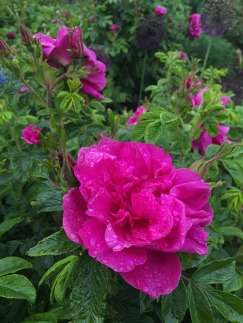
Any rose producing round, tomato-like hips with long, wriggly appendages is a rugosa. The edible, orange-red hips turn sweeter after a frost and provide a good source of antioxidants and vitamin C. While the comparison with tomatoes or crab apples is more common, they remind me of Christmas tree baubles.

The classic way to identify a rugosa before the hips appear is by the distinctive foliage. Rugosa leaves are thicker than those of other roses, and are deeply veined, giving a wrinkled effect.
Rugosa roses are often used for hedging or landscaping, where their upright, thorny stems act as a deterrent to would-be intruders. Far from temperamental in temperate climates, rugosas are hardy, less troubled by salt spray than other roses and are vigorous and disease-resistant enough to handle neglect.

I’ve noticed some interesting autumn colour on rugosa roses in the neighbourhood, the leaves turning yellow, orange and russet. It’s nice to be able to enjoy yellow leaves on a rose – normally, this would not be a great sign!

Most rugosas used for landscaping have single flowers, but semis and doubles are available, including Rosa ‘Wild Edric’, ‘Roseraie de l’Hay’ and ‘Hansa’. Pink and white forms are often mingled together in planting schemes. The fragrant flowers are produced for a long time, increasingly alongside clusters of hips as the year progresses.

Rugosa roses are considered invasive in some parts of the world, so check the position locally before taking the plunge.



Great photos. A house down the lane, aptly named Rose Cottage, has species roses on their Cornish hedge, but few hips this year
Have they been eaten or picked for something, I wonder? The local birds have been making the most of the ones round here.
Hips! They are almost as compelling as buds! These are beautiful, and I am loving all, but the first and last, especially the last, look absolutely Chihulian. Wonderful images. And, at year’s end, nicely comforting.
They do, but on a smaller scale. I think I prefer hips to buds, although we could not have one without the other.
The northern New England coastline is edged with thousands of rugosas. Their petals make an excellent potpourri with fragrance that lasts for years. When I lived in that area, I’d collect them, but haven’t been back for many years.
That’s good to know. I’ll be tempted to gather some next year.
My first encounter with rose hips was in a tea – a horrible, bitter concoction, steeped for so long it was opaque. Even now I shudder to recall my distaste for the brew.
BUT! I am a very big fan of rugosa roses for many reasons – their hardiness, their heady fragrance, and the fact that birds, if not this human, appreciate the fruit after the blooms are spent.
This year I saw a planting alongside a municipal water treatment plant – the hips were enormous – the size of ping-pong balls.
You still won’t get me to drink the stuff, though.
Your comment made me remember being given rose hip syrup as a child. It was sweet and quite scented.
I have one which I grew from a cutting and I’ll be thrilled if it has hips as beautiful as the ones in your photos. Possibly lack of water will have some bearing on that, though.
I hope so too. Did it take long to reach a good flowering size? I’ve always been surprised how quickly English roses flower from seed, and how slowly some of the species roses grow.
It’s a sizeable bush which has been in the garden now for a couple of years, so I would say it has grown very vigorously. It had flowers the next season after I planted the cutting!
Lovely photos. I love the season of hips as much as the flowers themselves.
I always enjoy plants that flower at the same time as they fruit. Blackberries are some of the best for that with the flowers, green fruits, ripe berries and shrivelled up ones on the same plant.
Exactly! I love that too!
ooh you are making me want to make rose hip jelly – maybe after I have made the medlar cheese and jelly!
I hope you have plenty of jars!
Did until MrB made llbs of mincemeat last week. I may have to forgo the rose hip jelly!
Beautiful pictures
Interesting information
Thank you.
You’re welcome
Those are fabulous rose-hips! I shall always think of them as Christmas decorations now… 🙂
I’m glad 🙂
Lots of rugosas along our Maine coast, and how I love looking at them and smelling them. Not as common inland. A gift for the senses by the sea.
It would be interested to know what proportion were planted and what seeded themselves. They don’t seem very invasive here, but they are persistent.